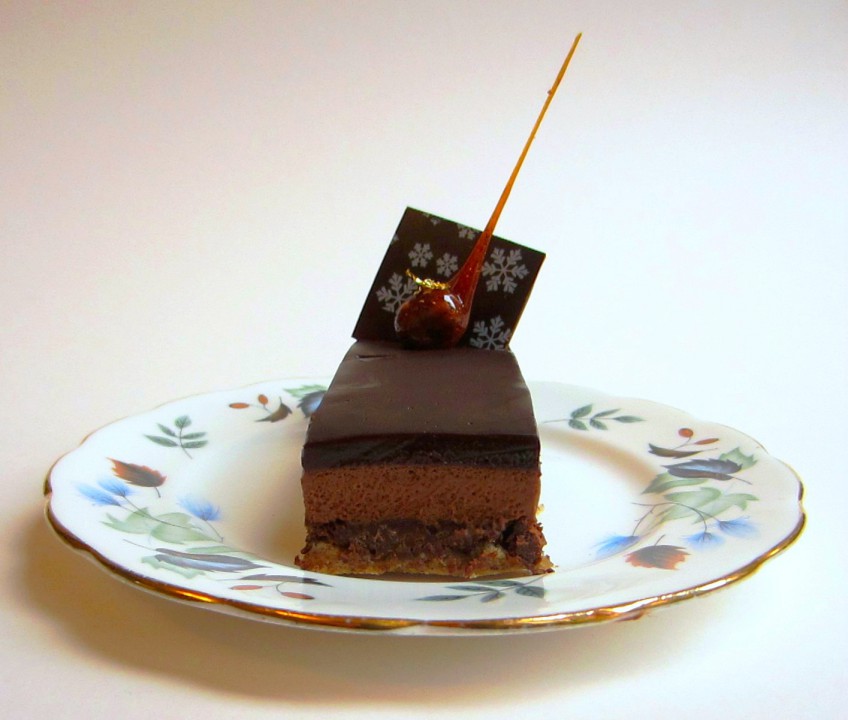
This recipe has been sat in my browser favourites / bookmarks for quite some time, ever since I first saw the recipe on Sous Chef. The Louis XV dessert is so called because it is served at Le Louis XV Restaurant, which is part of the Hotel de Paris, Monte Carlo, Monaco. The restaurant comes under the leadership of Alain Ducasse and he has been at the helm for 25 years.
The dessert is synonymous with the restaurant and has become somewhat of an icon for the establishment. When I saw that this dessert was steeped in so much history, I decided that it had to finally be made. It also dawned on me that it’s very unlikely I’ll visit Monaco, let alone Le Louis XV where this dessert retails at a mere £23. So if I ever wanted to taste it, I’d better make it myself.
I’m not sure how authentic this recipe is, but I have adapted it slightly, as some elements were over complicated and I found some of the components didn’t work as well as other recipes I’d tried. The dessert is comprised of a hazelnut dacquoise, a feuilletine praline layer, chocolate mousse and dark chocolate ganache glaze.
If you’re wondering what a dacquoise is, let me explain. It’s a type of cake made of meringue mixed with nut flour or ground nuts and a small amount of flour. The end result is a nutty, slightly chewy light cake, that in this instance is flavoured with hazelnuts, almonds and other nuts can also be used. The mixture is piped onto a baking tray to get an even layer and to ensure as much air is kept in the mix as possible.
The feuilletine praline layer, I have made before when making the Jaffa Cake Entremet. This is the first modification I made to the recipe. The instructions in the original involved making a caramel so that you could turn hazelnut paste into hazelnut praline paste. I had some hazelnut praline paste in my baking cupboard, so I used the recipe from William and Suzue Curley’s book Patisserie, this is a much simpler recipe and it produces consistently good results.
The mousse is made using a sabayon method of cooking the egg yolks and a sugar syrup over a bain marie. The mixture is then whipped, mixed with melted chocolate and whipped cream. This recipe used double cream and I followed the recipe, however I personally think that whipping cream produces lighter and more stable results than double cream, so I shall be using whipping cream in my recipes in future.
The cakes are assembled in a cake ring and left in the freezer overnight, you could probably get away with a shorter freezing time of about 4 hours, but I wanted to be confident the cakes were frozen before glazing.
There are quite a few possibilities for the size of desserts you can make. I made a 20cm square dessert and 10cm round dessert. The dacquoise produces a standard baking tray of cake, so you can make anything the size of the baking tray. Obviously if your cake is really large then the mousse and feuilletine layers will be thinner, so my advice would be don’t try to use all of the cake, unless you’re going to make extra mousse.
The glaze I made, follows the recipe. However I found that the inclusion of cocoa powder made my glaze lumpy and the consistency was too thick to be able to pour it neatly. Your glaze really needs to be a good pouring consistency because you want the glaze to level itself out and not need to be smoothed with a knife, this will leave you with a true mirror finish. The glazed cakes then need to be left in the fridge to set.
So if you use the glaze in the final recipe, your cakes will be even shinier than mine, the leftover glaze can also be frozen to use at a later date, or stored in the fridge for up to a week.
I also changed the decorations for the finished cake. I opted for a caramelised hazelnut, tempered chocolate squares decorated with chocolate transfers and some gold leaf. The hazelnuts are very easy to make, a dry caramel (caramel made with only sugar, no water is added) is made and the hazelnuts are pierced with a cocktail stick and dunked into the caramel. The hazelnut is then left somewhere to drip dry and this then forms the spike.
The caramel is really susceptible to moisture, meaning that they melt and lose their spike. So when you’ve made the hazelnuts use them to decorate the cakes at the last minute as the cakes will need to be stored in the fridge. If anyone knows how to stop the sugar dissolving/melting please let me know, as I’ve had the hazelnuts become tacky even when stored in an airtight container.
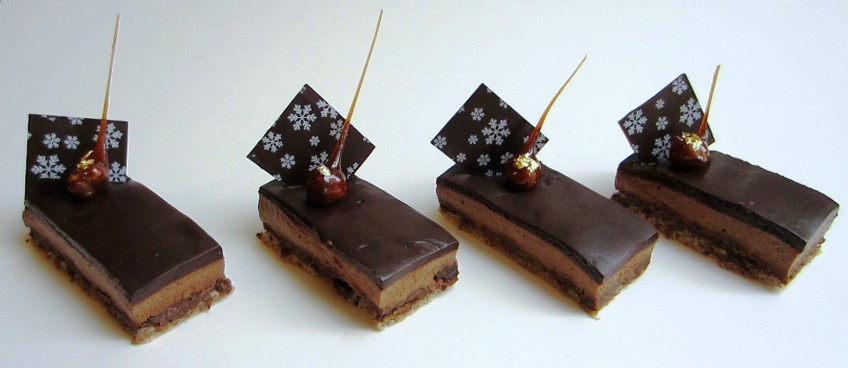
If you make a large rectangular cake and you want to cut it into portions and ensure that you have neat defined layers, you will need a long straight edged knife. There are pastry specific knives, but I have to admit I use a long carving knife to cut up my cakes, so if you have one of these it will work just as well. I do intend to get a pastry knife, but at the moment, it’s another thing to add to my long list of things I want!
The only other things you then need are, a large jug full of very hot water and some kitchen roll. When you come to cut the cake, heat your knife in the hot water and wipe it dry with the kitchen roll. Trim the edges of the cake to neaten them, to do this slice straight downwards in one fluid movement and push the offcuts away from the cake, do not drag the knife through the cake. Then dip your knife in the water, wipe it dry with a fresh piece of paper towel and continue to make cuts in this way until you have your desired portion sizes.
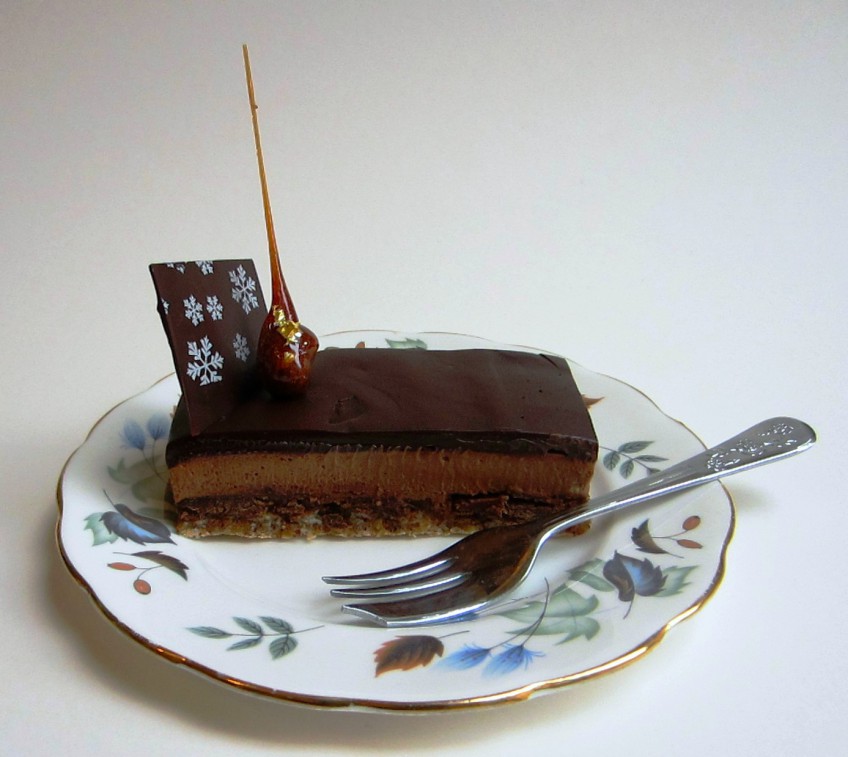
If like me, you’re unlikely to visit Monaco and you want to make this dessert for yourself, here’s the recipe:
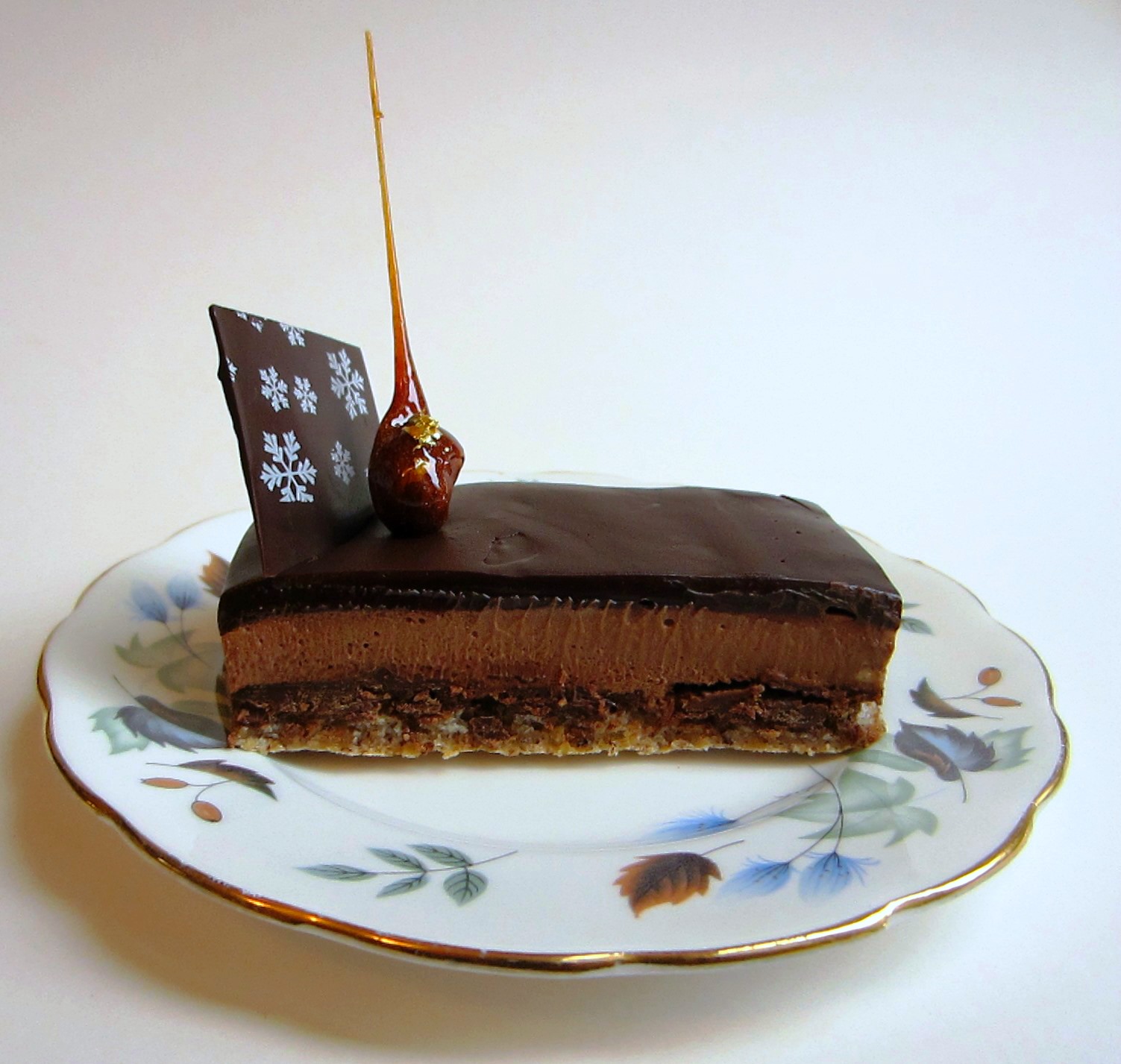
LOUIS XV DESSERT
Ingredients
- ***Hazelnut Dacquoise***
- 170 g Egg Whites
- 50 g Caster Sugar
- 120 g Icing Sugar
- 100 g Hazelnuts
- 25 g Plain Flour
- ***Feuilletine Praline Layer***
- 100 g Chocolate
- 10 g Cocoa Butter
- 75 g Hazelnut Praline Paste
- 90 g Feuilletine Wafer
- ***Chocolate Mousse***
- 75 g Egg Yolks
- 30 g Water
- 25 g Caster Sugar
- 10 g Liquid Glucose or Glucose Syrup
- 135 g Dark Chocolate
- 270 g Whipping Cream
- ***Dark Chocolate Ganache Glaze***
- 260 ml Whipping Cream
- 50 g Caster Sugar
- 40 g Liquid Glucose or Glucose Syrup
- 250 g Dark Chocolate
- ***To Decorate***
- Tempered Chocolate Squares
- 75 g Caster Sugar
- 8 Hazelnuts
Instructions
- To make the dacquoise roast the hazelnuts in the oven at 150C for 15 minutes.
- Allow the hazelnuts to cool a little before blitzing them to a powder in a food processor. Be careful not to over blend or the hazelnuts will begin to form a paste.
- Turn the oven up to 180C and cover a baking tray (any size from 30x20 - 35x25 will work) in baking paper.
- Whisk the egg whites until foamy, add half the sugar and whisk until stiff peaks form. Add the remaining sugar and whisk again briefly.
- Sieve the icing sugar, hazelnut powder and flour together into a large bowl.
- Add the meringue in 2 batches to the dry mixture using a spatula.
- Pipe the dacquoise onto the prepared baking tray, this will fill the tray.
- Cook at 180C for 12-15 minutes until the cake has coloured slightly and springs back to the touch. Transfer to a cooling rack.
- When cool remove the baking paper and use rings to cut out your desired size of cake.
- To make the FEUILLETINE PRALINE LAYER melt the chocolate and cocoa butter together in a bain marie.
- Then add the hazelnut praline paste and mix thoroughly.
- Finally add the feuilletine wafer and mix thoroughly.
- Using a teaspoon or a palette knife spread a thin layer of the mixture onto the dacquoise inside the cake/mousse rings.
- To make the chocolate mousse add the water, sugar and liquid glucose to a pan and bring to the boil. Leave to one side to cool a little.
- Place the egg yolks and the cooled syrup in a stand mixer bowl. Place the bowl over a pan of barely simmering water and whisk constantly until the mixture reaches 55C.
- Transfer the bowl back to the stand mixer and whisk until the mixture cools and reaches ribbon stage (this is where the mixture when drizzled from a spoon keeps its form and ribbons on the surface of the mixture).
- Melt the chocolate in a bain marie and gently stir into the whipped eggs.
- In a separate bowl whisk the cream until it forms medium peaks, fold the cream into the whipped eggs gently, until fully mixed.
- Spoon the mousse into the mould(s) and level off with a palette knife before placing in the freezer.
- Freeze the mousse for at least 4 hours, but if possible, overnight is best.
- To make the dark chocolate ganache glaze, put the cream, sugar and liquid glucose in a saucepan and bring to the boil.
- Gradually add the hot liquid to the chopped chocolate, mixing constantly to form an even emulsion.
- The ganache can be made in advance and stored in the fridge for up to 1 week or frozen for a couple of months.
- To use the ganache allow it to defrost (if frozen) and then warm it to around 35C in the microwave or in a pan over the hob.
- Take your mousse rings from the freezer and pour a thin layer of glaze into the rings. Allow the glaze to cool and then set it in the fridge.
- The remaining glaze can be used on other cakes or kept in the fridge for up to 1 week or frozen for a couple of months.
- Using a chef's blow torch or a warmed towel heat the outside of the rings and remove them from the moulds.
- if you're making a large cake (square or rectangular) and you want to cut it into portions, get a long straight edged knife and a jug full of hot water. Put the knife in the hot water, dry it with a piece of kitchen roll and slice the cake straight through it, be sure to the pull the knife away from the cake so that you separate out the portions, rather than dragging the knife through the length of the cake. This will ensure you maintain the neat layers.
- Each time you make a cut put the knife in the water and dry it with clean kitchen towel.
- Alternatively you could just neaten the edges of the cake by cutting it and leaving this as one large celebration cake.
- To decorate you can add squares of tempered chocolate, gold leaf and you can make your own caramelised hazelnuts.
- Make a caramel by melting sugar until it is a thick light brown caramel. Put the base of the pan in cold water to stop the caramel cooking.
- Stick cocktail sticks/toothpicks into each hazelnut and use this to dunk the hazelnuts in the caramel, hold the hazelnuts over the pan to let the excess drain off.
- Then rest the hazelnuts on a surface and allow the caramel to drop down, giving you the long spike when the caramel has set.
- Then use these to decorate the cake(s) anyway you like.
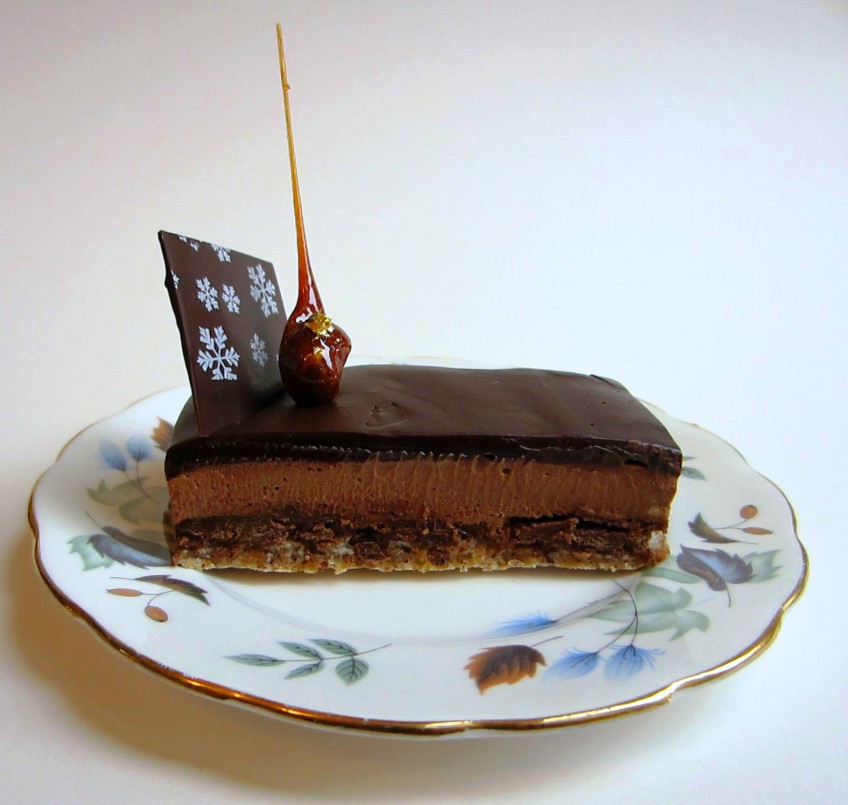
Are there any signature desserts or classic cakes that you’d like to make? Or perhaps you have made them and put your own spin on them. If so, let me know in the comments.
Thanks for reading.

Alasdair Cameron
I’m half way through making this and though I made s couple of errors it tastes great.
For caramel in think some silica packets can work.
patisseriemakesperfect
Glad you liked it Alasdair. it’s a delicious dessert.
Thanks for commenting.
Angela
Stacey Guilliatt
This is amazing! #tastytuesdays
PatisserieMakesPerfect
Thanks Stacey, it’s much easier to make than it looks as well. Thanks for commenting. #TastyTuesdays
Jodie Dodd
wow, looks incredible! i think i now understand why some of these decadent desserts are so pricey. not only the quality of the ingredients but the time and skill needed to make them. along with the specific equipment. it really is an art form.
PatisserieMakesPerfect
Aww thanks Jodie, I’m sure these restaurants use even more expensive and exclusive ingredients than I can afford! I buy the best chocolate I can, but I still have to reign it in
HonestMum
This is incredible, wow, utterly divine! Thanks for linking up to #tastytuesdays x
PatisserieMakesPerfect
Thank you! Happy to link up to #TastyTuesdays
Sarah
Was it worth what would’ve been a £23 price tag?! It looks very beautiful.
PatisserieMakesPerfect
I think so! I used really good chocolate (the best I can afford), but I like to think they would use even more amazing couverture chocolate than I can afford. This was divine.